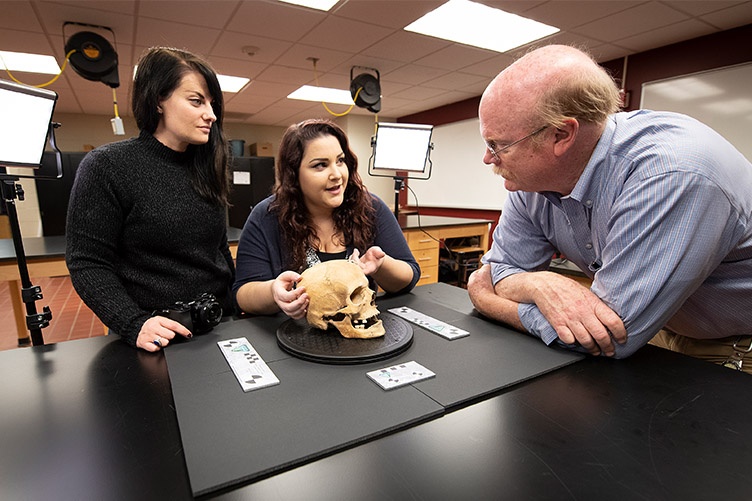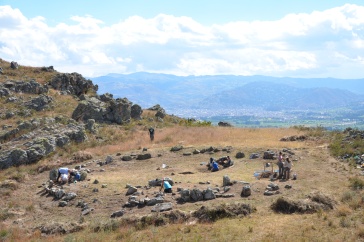
Biological anthropologist Amy Michael, Katie Titus, and associate professor Gregory McMahon are in the UNH archaeology lab discussing a skull that is part of a collection on which Titus practiced photogrammetry while preparing for Turkey.
It’s 5:30 a.m. and the morning call to prayer echoes out across the rural, largely Muslim village of Peyniryemez, in the Yozgat province of Turkey, rousing Katherine Titus from her slumbers. Katie, to those who know her, eats a quick breakfast of coffee, bread, jam and honey and hops a ride in an old van over to her dig site at a place called Çadır Höyük.
Çadır Höyük (pronounced “CHA-der HOY-ook”) is an artificial mound in central Turkey that contains the remains of some 6,000 years of human settlement. Ruined communities ranging from the Middle Chalcolithic era (3700 – 3350 BCE) to the Byzantine period (ending around 1075 CE) sit layer atop layer, reaching a height of 100 feet above the valley plain. That’s a roughly eight-story repository of the fortunes and misfortunes of a region and its many peoples.
There, Titus and her fellow Field School members work side-by-side with experienced archaeologists, learning how to handle a trowel and look for soil changes that indicate the presence of artifacts, architecture or bones. Titus is lucky: she was assigned to a trench at the base of Çadır Höyük — the lower the trench, the older its secrets. For the next eight hours, she’ll work at the site, with a much needed “second breakfast” waiting at the bottom of the mound at 9 a.m. and a lunch of fresh vegetables, eggs, lentil soup, rice pilaf and köfte (a patty made of meat or lentil) served at 2 p.m. Afterwards, she’ll work in the lab, drawing pottery or working on the excavation’s database of finds.
“Most of all, I learned how not to break things,” quips Titus, “especially since my trench was the most challenging — and rewarding — to dig due to the compacted soil.”
She caps off the summer of 2018 by finding a nearly 6,000-year old cup.
From Sunapee to Central Turkey
Raised on a small farm in Sunapee, NH, Titus had a lifelong interest in archaeology and foreign travel. “There was this old chimney that had crumbled in the woods where we played,” she says. “We called it ‘the brick place’ and it excited our imaginations about the past.” She is also of Armenian heritage and longed to learn more about her family’s ancestral home in Turkey.

A day in the trenches: Katie Titus (in red flannel and green hat) and colleagues excavating at Çadır Höyük, a huge mound in central Turkey that was home to 6,000 years of human civilization.
So, when she enrolled at UNH, she dove right into anthropology with a focus on archaeology, eventually taking Gregory McMahon’s course on the history of the Ancient Near East. In McMahon, Titus found somebody who not only inspired her to double major in history but who also directed a major archaeological project — Çadır Höyük — in, where else, but the very heart of the region from which Titus’ family had emigrated to America more than a century ago. “Anatolia, which is the name of Turkey before the Turks arrived, is easily the most interesting place in the world,” says McMahon. “The region lays at the crossroads of civilization. You had to cross it to go from Europe to Asia. Many different cultures took advantage of its rich farmlands.”
In the summer after her sophomore year, Titus joined McMahon for six weeks at Çadır Höyük’s Field School, where her interests in archaeology and history turned into passions for them.
Return to Çadır Höyük
Eager to return to Çadır Höyük, Titus spent her junior year learning to speak Turkish with McMahon and applying for a Summer Undergraduate Research Fellowship (SURF). She also acquired a state-of-the-art array of archaeological skills with her academic advisor Amy Michael, a UNH lecturer who specializes in bioarchaeology, the study of ancient skeletal remains. “Dr. Michael inspired me to pursue biological anthropology, which uses skeletal remains to determine the age, sex, growth and health of ancient individuals,” says Titus.

“Alas, poor Yorick …”: Katie Titus examines a skull dating millennia before Shakespeare. Titus used photogrammetry to create 3D images of three such skulls as part of her 2019 Summer Undergraduate Research Fellowship.
Through Michael, Titus learned how to use the relatively new technology of multi-image photogrammetry, which creates an accurate three-dimensional facsimile of surfaces and objects. “Bioarchaeologists use the tool for research and as a means of promoting cultural heritage preservation,” explains Titus.
After securing her SURF, Titus was eager to use her new skills to examine a collection of excavated juvenile human burials dating from 3700-3000 BCE that had been intentionally interred in the corners of ancient architecture. “Using skeletal biology and photogrammetry methods, I hoped to draw conclusions regarding cause of death,” says Titus. “Were they coincidental or part of a ritual sacrifice?”
Airline tickets in hand and summer itinerary set, Titus discovered that a senior Turkish scholar had recently taken the juvenile remains back to his own lab. Her reaction impressed the heck out of her mentors. “She didn’t miss a beat,” recalls Michael. “We worked hard before she left to make sure she was ready to go and be flexible when she got to site. So, Katie came fully prepared to fill a variety of roles and she did just that when she got to site.”
That “role” involved transferring her osteological techniques and photogrammetry methods from juveniles to adults. In one study, she re-analyzed the skeletal remains of a 1,000-year old Byzantine female whose skeleton had been badly misdiagnosed by a researcher reporting various deformities and miscalculating the age. “My analysis showed that she had, in fact, no visible deformities and was much younger than first reported,” says Titus.
A second study put her photogrammetry skills to use on three skulls from different eras. For this project, she built an apparatus consisting of a digital camera mounted on a tripod pointing at a turntable on which rested a pair of scales. One by one, she placed the skulls on the scales, switched on the turntable and took 140 photos at angles of 45, 90 and 180 degrees, running the images through special software that turned them into a manipulable, 3D facsimiles. The result, says Titus, is “a digital repository of the originals that are now available for use by anybody, anywhere in the world.”
A Promising Future
Titus presented her findings, “Preserving the Past for a More Ethical Future: Photogrammetry and Re-Analysis of a Bioarchaeological Sample from Çadır Höyük in Central Turkey,” at the university’s annual International Undergraduate Research Symposium in November. In addition, she presented a poster of her study at the American Schools of Oriental Research (ASOR) international conference November 20 – 23.
“For an undergraduate to get a poster accepted by ASOR is remarkable,” says McMahon. “I mean, she’s the first author and has a Ph.D. and graduate student as second and third authors.”
One of those other authors, Michael, concurs, pointing out that Titus’s “soft” skills matter just as much as her technical prowess. “Archaeology involves hard manual labor, tedious time in the lab analyzing artifacts, and communal living and teamwork. Katie’s been invited back to Çadır Höyük for a third time.
“She’s part of the team, and she’s going to be a fantastic bioarchaeologist.”
-
Written By:
Dave Moore | Freelance Writer

















































